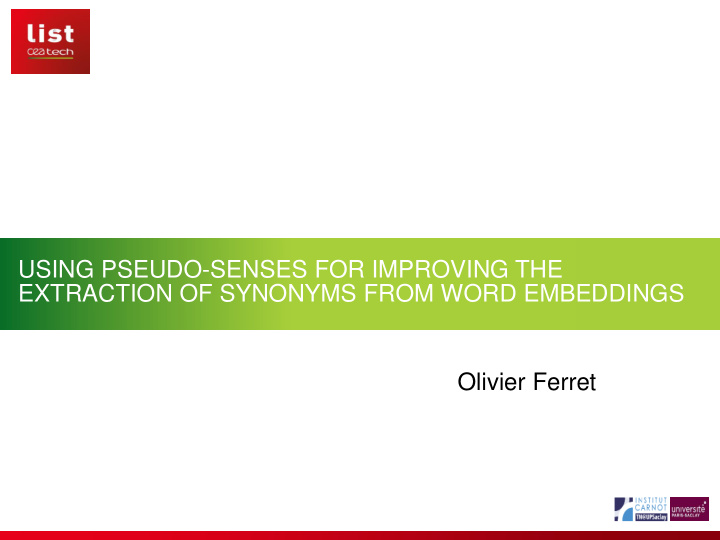



USING PSEUDO-SENSES FOR IMPROVING THE EXTRACTION OF SYNONYMS FROM WORD EMBEDDINGS Olivier Ferret
CONTEXT AND OBJECTIVES • Context • semantic specialization of word embeddings • most approaches following Retrofitting [Faruqui et al., 2015] • a priori set of lexical semantic relations • bring word vectors closer if they are part of similarity relations (synonymy, lexical association ...) • move them away from each other if they are part of dissimilarity relations (antonymy …) • Objectives of Pseudofit • improving word embeddings for semantic similarity without a priori lexical relations | 2
PRINCIPLES: GENERAL PERSPECTIVE • Theoritical hypothesis • homogeneous corpus C • equal split of C in 2 parts: C1 and C2 • distributional representation of a word w from a corpus C = distrep C (w) = set of contexts • distrep C1 (w) = distrep C2 (w) • In practice • distrep C1 (w) ≠ distrep C2 (w) • Hypothesis • differences between distrep C1 (w) and distrep C2 (w) are contingent • bringing distrep C1 (w) and distrep C2 (w) closer more general (and better) distributional representation of w | 3
PRINCIPLES: IMPLEMENTATION • Distributional representations • dense representations: Skip-Gram [Mikolov et al., 2013] • Notion of pseudo-sense • 2 sub-corpora 2 representation spaces • require projection in a shared space source of disturbances • instead, 1 corpus but 2 pseudo-senses for each word • pseudo-sense • arbitrarily split the occurrences of a word into two or more subsets • Overall process • generation of distributional contexts for pseudo-senses • turning pseudo-sense contexts into dense representations • convergence of pseudo-word representations more general word representation | 4
REPRESENTATIONS OF PSEUDO-WORDS • Generation of contexts • 2 successive occurrences of a word 2 different pseudo-senses • 3 representations / word • 2 pseudo-senses + word itself for each occurrence, generation of contexts for the current pseudo-sense + word • « frequency trick »: adding the representation of the word avoiding the impact of having half the occurrences for each pseudo-sense A policeman 1 was arrested by another policeman 2 . TARGET CONTEXT TARGET CONTEXT TARGET CONTEXT policeman a policeman 1 a policeman 2 another policeman be policeman 1 be policeman 2 by policeman arrest (x2) policeman 1 arrest policeman 2 arrest policeman by (x2) policeman 1 by policeman another • Building of dense representations • word2vecf [Levy & Goldberg, 2014] | 5
CONVERGENCE OF PSEUDO-WORD REPRESENTATIONS • Principles • 3 representations / word w: v (word); v 1 , v 2 (pseudo-senses) • v, v 1 and v 2 : supposed to be semantically equivalent 3 similarity relations: (v, v 1 ), (v, v 2 ) and (v 1 , v 2 ) • application of a semantic specialization method for word embeddings to v, v 1 and v 2 with the similarity relations between them • final representation for w: v after its « specialization » • Implementation • specialization method: P ARAGRAM [Wieting et al., 2015] • comparable to Retrofitting but includes an automatically generated repelling component • for each target word to specialize, selection of a repelling word, either randomly or according to their dissimilarity | 6
INTRINSIC EVALUATION • Experimental setup • 1 billion lemmatized words randomly selected from the Annotated English Gigaword corpus [Napoles et al., 2012] at the level of sentences • word embeddings built with the best parameters from [Baroni et al., 2014] • focus on nouns • Word similarity evaluation • Spearman’s rank correlation between human judgments and similarity between vectors for 3 representative datasets of word pairs SimLex-999 MEN Mturk 771 INITIAL 49.5 78.3 65.6 Pseudofit 51.2 79.9 68.0 Retrofitting 49.6 77.4 65.0 Counter-fitting 49.5 77.2 64.9 100 | 7
SYNONYM EXTRACTION • Evaluation framework • Gold Standard: WordNet’s synonyms • 2.9 / word • evaluated words = 11,481 nouns • frequency > 20 • for each evaluated noun, retrieval of its 100 nearest neighbors • neighbors ranked from most similar (Cosine) to less similar • Information Retrieval (IR) paradigm • evaluated word ≡ query; neighbors ≡ docs • IR measures: MAP, R-precision, precision@{1,2,5} R-prec. MAP P@1 P@2 P@5 INITIAL 13.0 15.2 18.3 13.1 7.7 Pseudofit +2.5 +3.3 +3.0 +2.5 +1.8 100 | 8
SENTENCE SIMILARITY • Evaluation task • Semantic Textual Similarity: STS Benchmark dataset [Cer et al., 2017] • Pearson rank correlation between human judgments and similarity between sentences for a set of reference sentence pairs • Computation of sentence similarity • strong baseline approach based on word embeddings • sentence representation: elementwise addition of the embeddings of the plain words of the sentence • use of Pseudofit [max,fus-max-pooling] embeddings, defined for nouns, verbs and adjectives • sentence similarity: Cosine between sentence representations ρ 100 INITIAL 63.2 Pseudofit [max,fus-max-pooling] 66.0 Best baseline (Cer et al., 2017) 56.5 | 9
CONCLUSIONS AND PERSPECTIVES • To sum up • Pseudofit: method for improving word embeddings towards semantic similarity without external semantic relations • method based on the convergence of several representations built from the same corpus more general representation • successful intrinsic and extrinsic evaluations for word similarity, synonym extraction and sentence similarity • Research directions • transposition of Pseudofit with several corpora link with researches about meta-embeddings and ensembles of word embeddings | 10
Commissariat à l’énergie atomique et aux énergies alternatives Institut List | CEA SACLAY NANO-INNOV | BAT. 861 – PC142 91191 Gif-sur-Yvette Cedex - FRANCE www-list.cea.fr Établissement public à caractère industriel et commercial | RCS Paris B 775 685 019
Recommend
More recommend